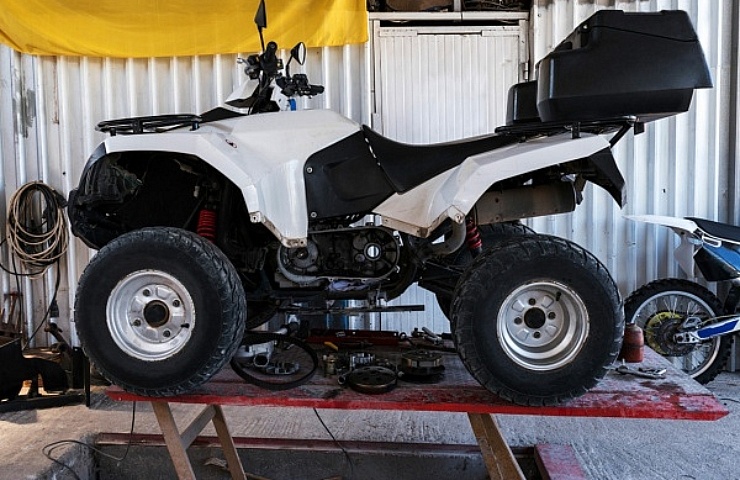ATV Riding Techniques: Understanding the Art of Off-Roading

Body Positioning
To successfully browse through difficult off-road surface, it is essential for ATV bikers to constantly maintain correct body placing. Maintaining the right body setting while riding an ATV not just boosts control and stability yet also guarantees the rider's safety. By adopting the right body positioning strategies, motorcyclists can efficiently disperse their weight, enhance their balance, and minimize the threat of injuries or mishaps.
One trick aspect of proper body positioning is maintaining the feet on the foot secures. Putting the feet on the foot fixes enables the motorcyclist to keep stability and control over the ATV. The motorcyclist's knees must be slightly bent, offering a slight suspension to keep and soak up shocks equilibrium. Furthermore, the cyclist's upper body need to remain unwinded and adaptable, enabling for quick and seamless activities when essential. This includes maintaining a light grasp on the handlebars to preserve control without excessive pressure.
Furthermore, the motorcyclist's eyes must always be concentrated in advance, scanning the surface and anticipating any challenges or changes in the path. By keeping an ahead gaze, cyclists can make instant decisions and respond properly to challenging surface.
Throttle Control
Structure upon the importance of appropriate body placing for ATV cyclists, mastering throttle control is a crucial skill that makes it possible for motorcyclists to successfully maneuver via different off-road terrains. Throttle control describes the ability to regulate the quantity of power delivered to the ATV's engine. By recognizing exactly how to adjust the throttle, bikers can ensure a controlled and smooth acceleration, allowing them to browse obstacles with accuracy.
Unexpected or jerky activities can cause the ATV to lose traction or end up being unpredictable, making it tough to maintain control. This technique enables the ATV to maintain a stable speed and supplies better grip, lowering the threat of crashes.
Along with smooth modulation, cyclists must likewise learn exactly how to balance the throttle with various other riding strategies, such as body positioning and braking. For example, when climbing high hillsides, bikers need to apply sufficient throttle to maintain energy without subduing the ATV or causing wheel spin. Likewise, when descending steep inclines, bikers must use the throttle in combination with proper body placing and braking to keep control and stop the ATV from moving or tipping over.

Braking Strategies
An essential aspect of ATV riding methods is understanding efficient braking strategies. It is important to bear in mind that severe braking with just the front brake can trigger the ATV to pitch forward, possibly leading to loss of control or even flipping over. By mastering these stopping strategies, you can improve your ATV riding abilities and make certain a risk-free and pleasurable off-roading experience.
Cornering Strategies
One essential aspect of grasping ATV riding methods is comprehending efficient cornering techniques. Catching why not try here on an ATV can be tough, yet with the appropriate strategies, motorcyclists can browse turns safely and successfully. The secret to effective cornering is to maintain control of the ATV while making the most of traction and lessening the risk of tipping over.
To carry out a proper cornering technique, riders must approach the turn at an ideal rate, ensuring they are not going too slow or as well fast. It is important to change the body weight in the direction of the within the turn, leaning right into it to preserve equilibrium and stability. This assists to counterbalance the centrifugal force and keeps the ATV upright.
In addition, bikers ought to maintain their eyes concentrated on the departure factor of the turn instead of the prompt course ahead (ATV). This permits for smoother and much more exact guiding, as it assists the biker prepare for any obstacles or adjustments in terrain
In addition, appropriate throttle control plays a considerable role in cornering. Cyclists must modulate the throttle efficiently, staying clear of sudden accelerations or slowdowns, which can create loss of control.
Uphill and Downhill Riding
When navigating off-road terrain, ATV motorcyclists should master the techniques for uphill and downhill riding to maintain control and ensure safety. Uphill riding requires a mix of equilibrium, throttle control, and weight distribution. As cyclists rose high slopes, they should lean onward to change their weight in the direction of the front of the ATV, which increases traction on the front wheels and prevents the vehicle from turning backward. ATV. Additionally, maintaining a consistent throttle and avoiding sudden velocity or deceleration helps to stop the ATV from shedding energy or obtaining stuck. Downhill riding, on the various other hand, needs riders to lean back and my review here change their weight towards the back of the ATV. This helps to keep stability and avoid the vehicle from flipping forward. It is vital to utilize the brakes moderately and apply them progressively to stay clear of securing the wheels and blowing up. In addition, riders ought to pick the path with the least barriers, as navigating downhill can be much more tough as a result of the raised rate and lowered grip. By understanding the strategies for uphill and downhill riding, ATV bikers can with confidence deal with numerous off-road surfaces and take pleasure in a exhilarating and risk-free adventure.
Verdict
In conclusion, grasping the art of ATV riding calls for a combination of body positioning, throttle control, braking techniques, and efficient cornering. Uphill and downhill riding likewise need particular abilities to browse safely. By implementing these strategies, bikers can improve their off-roading experience and enhance their total control and safety and security on the ATV.
ATV Riding Techniques: Understanding the Art of Off-Roading is a comprehensive guide that delves into the ins and outs of understanding the abilities needed for off-road ATV riding. Whether you are a novice or an experienced motorcyclist, ATV Riding Techniques: Grasping the Art of Off-Roading provides crucial advice to assist raise your off-road ATV riding skills to the next level.
